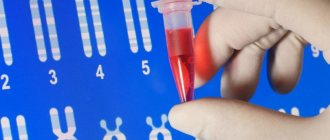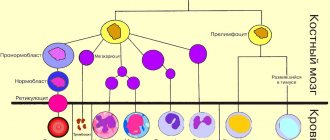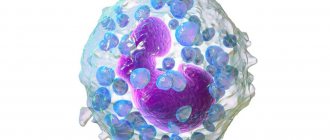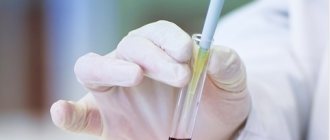What are platelets
Before you begin deciphering the analysis, it is worth understanding what platelets are.
Platelets are blood platelets, the smallest formed elements of blood. The formed elements of blood also include leukocytes and erythrocytes. Together with platelets, they make up the bulk of blood cells.
The functions of platelets are very diverse, but their role in the body is to control the performance of blood vessels by releasing various biological substances. The well-known function of platelets is their participation in the blood clotting process. In this case, platelet levels are associated with the formation of bleeding and blood clots.
Mechanism of action
It may seem strange that such tiny blood cells play such a significant role in the functioning of the body. How does this happen?
The bottom line is this: platelets accumulate in large numbers where there is tissue damage, accompanied by blood loss. Here they connect and collapse, forming a protective sphere in the form of a blood clot, which stops the bleeding.
- Platelets are elevated in an adult - what does this mean, and how to reduce them?
In addition to performing this function, blood platelets provide nutrition to the protective layer of blood vessels - the endothelium.
Conditions in which platelets are elevated in a child
An increased number of platelets in the blood is called thrombocytosis.
The reasons for their increased level may be:
- enhanced hematopoietic processes in the bone marrow , which leads to a high concentration of platelets in the blood and other formed elements;
- high platelet consumption , resulting in a compensatory increase in their number;
- infectious process (tuberculosis);
- taking medications and others.
A high level of platelets in the blood is dangerous because it thickens the blood and increases the risk of blood clots. Only a doctor can tell you more accurately whether a child’s platelets are elevated or not.
Platelets in babies
The norm of platelets in children (their content in the blood) is directly dependent on age:
- in newborns up to the 10th day from birth – 100-420×109/l of blood;
- in babies under 1 year of age – 150-350×109/l;
- in children after 1 year, as in adults – 180-320×109/l.
If the platelet count doubles, doctors consider it a critical condition.
Elevated platelet levels in children may indicate the presence of serious diseases such as leukemia.
Low platelet count
A few words should be said about low platelet levels. Low platelet count in the blood – thrombocytopenia. Due to the fact that platelets take part in blood clotting processes, a lack of them in the blood can lead to bleeding.
The reason for a low platelet count in the blood may be, for example, inhibition of bone marrow hematopoiesis as a result of radiotherapy or if there are factors leading to their destruction in the blood. The latter may include autoimmune diseases. There are cases when thrombocytopenia is hereditary, for example, Wiskott-Aldrich syndrome, Bernard-Soulier syndrome .
You can tell that your child has platelet problems by the presence of a rash or bruises that quickly appear when touched.
Platelets: friends or enemies?
Today we will talk about cells, life without which, without exaggeration, would be impossible.
Galina Petrovna Episheva, a therapist at the Expert Clinic Kursk, talks about platelets.
— Galina Petrovna, what are platelets?
— This is one of the types of blood cells (along with red blood cells and leukocytes). Sometimes they are also called blood platelets. The diameter of the platelet is small - only 2-3 microns. It has no core. The platelet contains a large number of granules containing substances of various chemical compositions.
Platelets are produced by red bone marrow, their predecessors are large bone marrow cells - megakaryocytes.
— What is the role of platelets in the body?
— Today the following functions of platelets are known:
- they protect the walls of blood vessels from mechanical damage;
- prevent blood loss;
- nourish blood vessels;
- participate in the regeneration (restoration) of damaged tissues.
There are also reports that platelets have some antiparasitic effects.
— What is the platelet rate in humans?
— The platelet count is measured in thousands per 1 μl (microliter) of blood (the measurement in liters is also used). The norm is determined depending on gender:
- for men – 200-400 thousand/µl (or, otherwise, 200-400x109/l);
- for women – 180-320 thousand/µl. During menstruation, the rate may decrease, ranging from 75 to 220 thousand/μl. A decrease can also be observed during pregnancy - approximately 100-310 thousand / μl.
In children, the platelet count changes according to age.
Please note that the normal platelet count in the blood may vary depending on the specific laboratory in which the analysis is performed.
— If platelets are increased or decreased, what does this mean? What can lead to an increase or decrease in their number?
— The reasons for the increase in platelets may be:
- stress;
- physical overload;
- use of certain medications (increased platelet count as a side effect). For example, these could be corticosteroids, adrenaline;
- injuries (fracture, cuts, burns);
- erythrocytosis;
- some types of leukemia (leukemia);
- a number of infections;
- enteritis;
- pneumonia;
- acute meningitis;
- anemia;
- autoimmune diseases (rheumatoid arthritis, sarcoidosis, vasculitis);
- cirrhosis of the liver;
- splenectomy.
Reasons for a decrease in platelet count may include:
- pregnancy;
- idiopathic thrombocytopenic purpura (Werlhof's disease);
- use of a number of medications (decreased platelet count as a side effect). For example, these could be antidepressants, antibiotics;
- oncopathology, including tumors of the hematopoietic system;
- chemotherapy;
- hypothyroidism and hyperthyroidism;
- bleeding;
- severe injuries;
- long menstruation;
- liver diseases (in particular hepatitis);
- surgical interventions;
- avitaminosis;
- poisoning with alcohol, heavy metals;
- HIV infection.
— Does it happen that the number of platelets is normal, but their functions are impaired?
- Yes. Platelet dysfunction can result from many causes. I will list some:
- mutation of genes responsible for platelet membrane glycoproteins. This happens, for example, with thrombasthenia - Bernard-Soulier disease;
- abnormalities of platelet granules, in particular, deficiency of dense granules containing ATP, calcium, serotonin;
- changes in the function of cytosolic enzymes, other platelet proteins and a number of others.
— How to identify problems with platelets, in particular, changes in their number and function?
— A number of studies are being carried out. Among them:
- complete blood count with platelet determination;
- coagulogram (blood clotting test);
- study of platelet aggregation.
You can read more about a general blood test in our article
— For what pathological processes and conditions is a platelet test prescribed?
— The list of them is extensive. This:
- injuries;
- thrombosis and thromboembolism;
- blood loss;
- anemia and erythrocytosis;
- leukemia, lymphogranulomatosis, other oncological pathologies;
- poisoning;
- enteritis;
- liver diseases;
- hypo- and hyperthyroidism;
- hypersplenism (increased spleen function);
- prolonged menstruation;
- alcoholism;
- chemotherapy.
— What complaints and signs can be a reason to study the number and functions of platelets?
— The appearance of hemorrhages/bruises (“bruises”) on the skin and/or mucous membranes is typical, and not necessarily associated with even a minor injury. In other words, they can arise spontaneously. The patient may also experience bleeding gums and possible nosebleeds. In women, the duration of menstruation increases.
— How to properly prepare for a platelet test?
— If we are talking about determining the number of platelets in a general blood test, then this is:
- observing a 12-hour fast before donating blood;
- exclusion of fatty foods and alcohol on the eve of the study;
- 2 hours before taking blood, it is advisable to limit physical and emotional stress, stress; you should not smoke for half an hour.
— Which doctor should you contact if you have symptoms indicating a possible platelet problem?
- See a therapist, general practitioner or specialist - an otolaryngologist (for example, for nosebleeds), a gynecologist (for prolonged menstruation). Based on the results of the survey, examination and tests, a consultation with a hematologist or other specialist may be recommended.
You can make an appointment with specialists here
ATTENTION: the service is not available in all cities
Interviewed by Enver Aliyev
The editors recommend:
Leukocytes. What will a blood test tell you?
What does a biochemical blood test show?
Immunity is not on the side of Rosa Luxemburg and Clara Zetkin. Why doesn't nature recognize equality?
For reference:
Episheva Galina Petrovna
She graduated from the Faculty of General Medicine of Kursk State Medical University in 1990.
From 1990 to 1991 she completed an internship in therapy. Doctor of the highest category.
Currently a general practitioner at the Expert Clinic Kursk. Receives at the address: Karl Liebknecht St., 7.
Test to determine the level of platelets in the blood
What tests can be prescribed, including counting platelet levels in the blood? One of these tests is a general clinical blood test. This is a study of the level of red blood cells, white blood cells and platelets together. Depending on the equipment the laboratory is equipped with, other blood parameters may be determined.
Most often, a hematology analyzer is used for general clinical blood analysis. Therefore, there are a number of factors influencing the reliability of the results.
Sometimes, if the indicators are inadequate or questionable and do not correspond to the clinical picture, a separate study of platelet levels may be prescribed. It is carried out manually, and in this case it is more reliable, as it helps to avoid erroneous readings from the device.
How to prepare properly
One of the important components when preparing for a general blood test is the emotional calm of mother and child.
Drawing blood is stressful and can lead to fluctuations in your readings, so it’s best to be mentally prepared for it. Blood must be donated on an empty stomach. But in infants this is difficult to comply with, so it is allowed to donate the material between feedings.
Also, the child’s hands should not be cold. At low temperatures, the capillaries spasm, blood flow slows down, and the procedure may be delayed.
It is important to sit or lay the child down so that he is comfortable.
Where to get tested for free and for a fee
If you have a compulsory medical insurance (compulsory health insurance) policy, you will be able to test the level of platelets in your blood free of charge. If suddenly, for some reason, you do not have the desire or opportunity to visit your medical institution to which you are attached, then you can contact any medical center that provides paid services.
How much does platelet determination cost in Moscow laboratories?
Determining the number of platelets during a general clinical blood test in laboratories in Moscow will cost you 250-400 rubles; in addition, you may be required to pay money for taking blood. To avoid being deceived, visit the website of a specific medical center. There is almost always a price list there.
You can also additionally request a manual method of platelet counting (according to Fonio). It will cost you somewhere around 200-300 rubles. Some medical centers do not separately conduct manual platelet level testing, only as an additional method. Therefore, you need to be prepared for this.
Treatment
To treat primary thrombocytosis, the cytostatics Myelobromol, Myelosan and others are used for a long time until results are obtained.
In severe cases, in addition to cytostatics, thrombocytopheresis is used (removal of platelets from the bloodstream using special equipment).
Drugs that improve microcirculation and prevent the adhesion of blood platelets (Trental, aspirin, etc.) are also used. Aspirin can be used only if erosive changes in the digestive tract are excluded.
For clonal thrombocytosis, antiplatelet agents (Ticlopidine or Clobidogrel) are used in individual dosages.
In case of thrombosis or ischemic manifestations, anticoagulants (Heparin, Argotoban, Livarudin, Bivalirudin) are used under daily laboratory monitoring of platelet counts.
For secondary thrombocytosis, treatment includes therapy of the underlying disease and prevention of thrombosis associated with an increased platelet count. As a rule, reactive thrombocytosis does not lead to thrombohemorrhagic complications and therefore does not require special therapy. The prognosis is usually favorable.
In addition to drug treatment for thrombocytosis, it is important to provide the child with a balanced, rational diet rich in vitamins (especially group B). Breastfeeding is the most beneficial for infants.
Older children are recommended to consume the following foods:
- rich in iodine (seafood, nuts);
- rich in calcium (dairy products);
- iron-rich (offal and red meat);
- freshly squeezed juices (pomegranate, lemon, lingonberry, orange), diluted with water 1:1.
The following have a thinning effect on the blood: berries (cranberries, sea buckthorn, viburnum), lemons, ginger, beets, fish oil, flaxseed and olive oil, tomato juice and a number of other products.
It is very important to drink enough fluid (at the rate of 30 ml/kg). In addition to water, you should drink green tea, compotes and vegetable decoctions.
Bananas, mangoes, rose hips, and walnuts contribute to blood thickening.
Herbal medicine should not be used without the consent of a hematologist - after all, herbs are quite serious drugs and, if chosen incorrectly, can significantly aggravate the child’s condition.
Decoding indicators
When receiving the research results in person, for example, in a paid center, many parents immediately begin to explore the Internet. They check the level of platelets in the blood using unreliable sources, make their own conclusions, and prescribe treatment.
Parents who care about the health of their child will turn to a specialist, for example, a pediatrician or hematologist, for a transcript of the analysis. If deviations are detected, the patient will be referred to additional research methods to clarify the reasons.
Causes of thrombocytosis
Thrombocytosis can be caused by:
- increased production of blood platelets by megakaryocytes of the red bone marrow (with erythremia);
- slow platelet utilization (when the spleen is removed);
- disturbance of the distribution of platelets in the bloodstream (due to physical or mental stress).
When an elevated platelet count is detected, it is very important to determine the cause of this condition. Only a pediatrician or hematologist (a specialist in blood diseases) can identify this cause.
Thrombocytosis as a disease can develop in children at any age. But such a diagnosis is made with a significant increase in the number of platelets - more than 800 thousand/l. More often, a mild increase in the number of blood platelets occurs due to a number of reasons or in a number of diseases.
There are primary , clonal and secondary thrombocytosis.
With clonal thrombocythemia, there is a defect in the stem cells themselves in the bone marrow (they are damaged by the tumor process). They do not respond to stimulation of the process by the endocrine system, and the process of platelet formation becomes uncontrollable.
A similar mechanism is observed in primary thrombocythemia . It is associated with the proliferation of several areas of the red bone marrow and, as a consequence, with an increase in the number of newly formed blood platelets. The causes of this condition can be hereditary (congenital) diseases or acquired (myeloid leukemia, erythremia).
In primary thrombocytosis, the number of blood platelets can vary: from a slight increase to several million in 1 μl, but high levels are more typical. In addition, their morphology also changes: platelets of enormous size and altered shape are found in the blood smear.
The mechanism of development of secondary thrombocytosis can be different:
- when the spleen is removed, old or obsolete platelets do not have time to destroy, and new ones continue to form; in addition, the spleen produces antiplatelet antibodies and a humoral factor that inhibits platelet production;
- During the inflammatory process, the body intensively produces a hormone (thrombopoietin), which promotes the maturation of blood platelets, which help cope with inflammation; biologically active substances (for example, interleukin-6) are anti-inflammatory cytokines that stimulate platelet synthesis;
- in malignant diseases, the tumor produces biologically active substances that have a stimulating effect on bone marrow megakaryocytes and the production of blood platelets; this is more often observed in lung sarcoma, kidney hypernephroma, lymphogranulomatosis;
- thrombocytosis also develops as a response of the body to repeated blood loss (with ulcerative lesions of the intestine, with cirrhosis of the liver),
Secondary thrombocythemia (symptomatic or reactive) can develop in a number of diseases:
- tuberculosis;
- iron deficiency or hemolytic anemia;
- rheumatism in the active stage;
- ulcerative colitis;
- osteomyelitis;
- chronic and acute infections (viral, bacterial, fungal, parasitic);
- extensive surgical interventions;
- removal of the spleen (for injuries or hemophilia);
- acute blood loss;
- fractures of tubular bones;
- cirrhosis of the liver;
- amyloidosis;
- malignant diseases.
Secondary thrombocytosis is characterized by a less pronounced increase in the number of platelets: in very rare cases, their number exceeds a million in 1 μl. The morphology and function of blood platelets are not impaired.
In any case, detected thrombocytosis requires a full examination and clarification of the cause of its occurrence.
In addition to diseases, it can also be caused by side effects of medications (Vincristine, epinephrine, adrenaline, corticosteroids, etc.). There are no specific symptoms of thrombocytosis.
When an increased platelet count is initially detected, the following studies must be performed:
- determination of serum iron and serum ferritin;
- determination of C-reactive protein and seromucoids;
- blood coagulation analysis;
- Ultrasound of the abdominal and pelvic organs;
- if necessary, consult a hematologist;
- bone marrow examination (only as prescribed by a hematologist).










